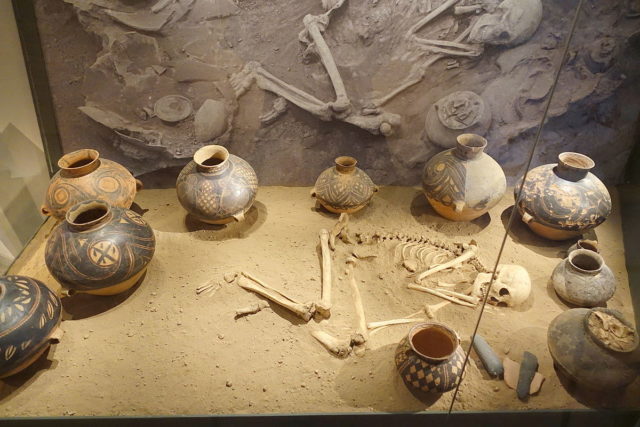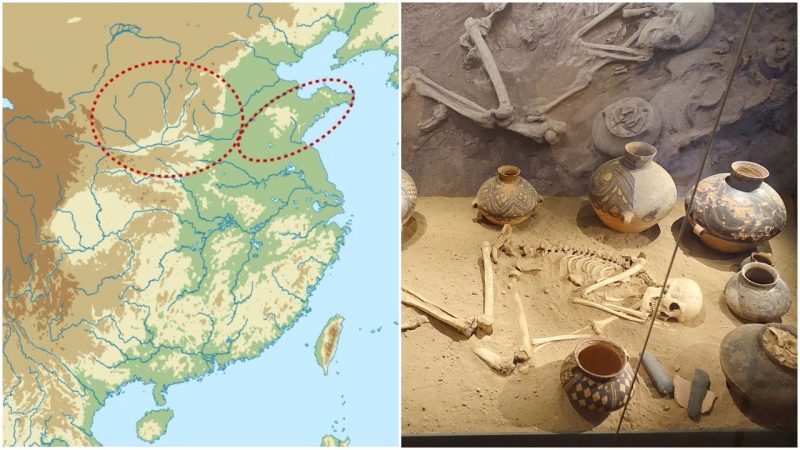Every now and then archaeologists produce fascinating, if not baffling reports. The latest one, in China, concerns a graveyard of “giants” buried approximately 5,000 years ago, unearthed by archaeologists in the village of Jiaojia.
According to archaeologists, the skeletons found in a village in the proximity of Jinan city, the capital of the eastern Chinese province of Shandong, are unusually tall. The bone measurements of one man reportedly reaches the height of six foot three inches. A few more skeletons that are at least five foot eleven inches have also been found, taller than many modern-day males.
The Jiaojia village has been the workplace of archaeologists since 2016, and currently, their subjects of excavation are the ruins of 104 houses, 205 graveyards, and 20 pits that most likely had a sacrificial function. The entire effort will call for extracting more knowledge from the relics that relate to the Longshan culture, a late Neolithic civilization that once thrived across the middle and lower reaches of the Yellow River.

Fang Hui, who is the head of Shandong University’s school of history and culture, has provided statements for China Daily, saying the measurement is based on the bone structure, and when these individuals were alive, their height could exceed six foot three inches.

Fang says in explanation that “already agricultural at that time, people had diverse and rich food resources and thus their physique change.” While the major crop that this civilization cultivated was millet, evidence of pig bones and teeth found in some of the graveyards tells us something. Moreover, previous finds have shown rice, wheat, as well as animals such as sheep, goats, and dogs.
Archeologists in China have made a shocking discovery as they exhumed tombs in Jiaojia village, China. https://t.co/PAnltZgvIU
— Neon Nettle (@NeonNettle) July 4, 2017
Fang Hui explains that food was certainly a factor that enabled these people to grow so tall. Today, men aged 18 living in the region have an average height of five foot nine inches, which is still more than the national average of five foot eight inches.
The human remnants excavated recently would have certainly seemed gigantic in comparison to the average person five millennia back as well. The tombs where the skeletons laid were also large, and according to archaeologists that would designate the persons were likely of higher status and had privileges and powers.
Archeologists find 5,000-year-old “giants” in east China’s Shandong, height may reach 1.9 meters https://t.co/7FJJqkvVev pic.twitter.com/0MCazsyXIY
— China Xinhua News (@XHNews) July 3, 2017
Archaeologists have discovered a number of other artifacts at the Longshan site. It should be mentioned this culture is world famous for its eggshell black pottery and the first related archaeological finds of it took place at the Chengziya Archaeological Site as early as 1928. Excavations were subsequently conducted in 1930 and 1931, and the culture was named after the nearby modern town of Longshan, which in Chinese literally means “Dragon Mountain.”
Astonishing skeletons of 5,000-year-old ‘giants’ found in China https://t.co/gH46dloFzv pic.twitter.com/lYSpkEK38D
— The Independent (@Independent) July 5, 2017
This civilization once thrived in the territory of modern-day Shandong province and their most distinctive trait of high-level skill in pottery making was widespread in north China. They knew how to use pottery wheels and were more than capable of producing thin-walled and well-polished black pottery, remnants of which have been found all the way to the Yangtze River Valley and even further to the southeastern coast of China.
Did giants roam the earth? Archeologists in east #China find 5,000 year old, 6.2 ft tall giant human skeletons https://t.co/JU05zh3mvN pic.twitter.com/rAA9JNrzJt
— People’s Daily,China (@PDChina) July 4, 2017
The population of the Longshan culture dramatically expanded towards the 3rd millennium BC, but then notably shrank in most areas later. It was at that point when the central area evolved into the Bronze Age Erlitou culture, which, according to Chinese archaeology, is commonly identified as the site of the Xia dynasty, the first dynasty in traditional Chinese history. Still, there is a lack of strong evidence to verify the latter linkage.
It seems many questions remain unanswered about the ancient Chinese civilization, and it is hoped that more insights will be provided through further excavations and new findings.
